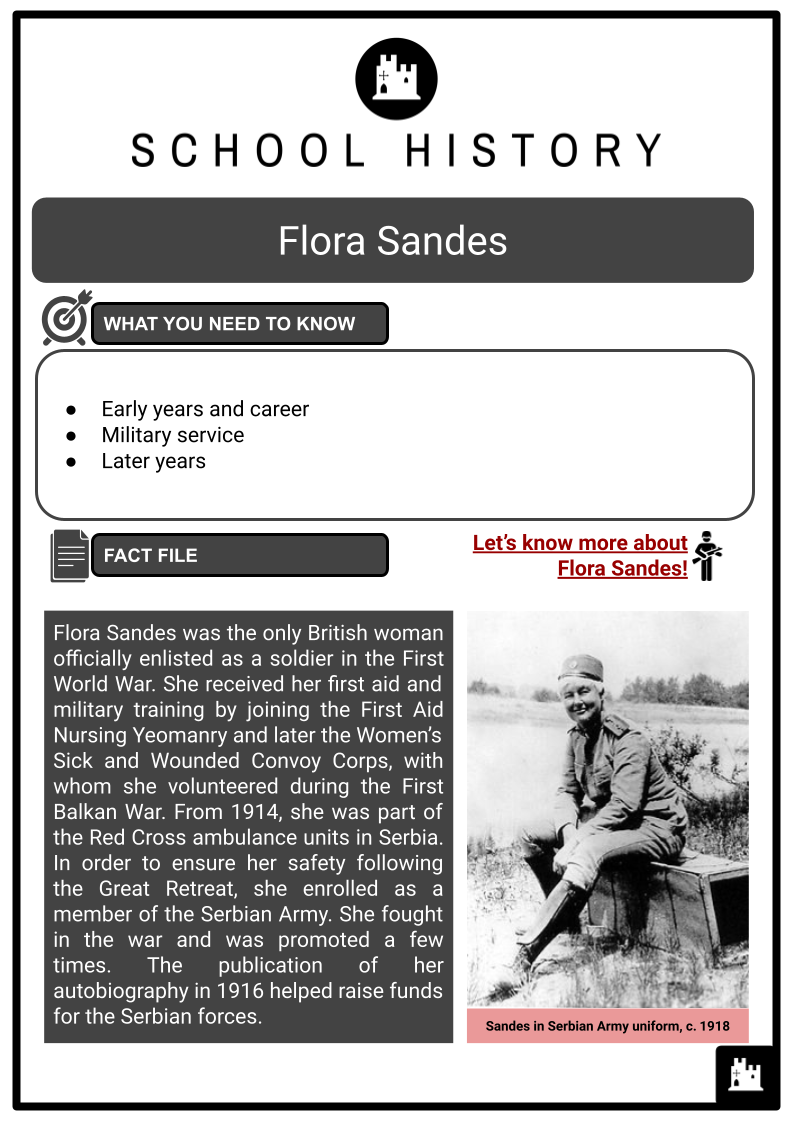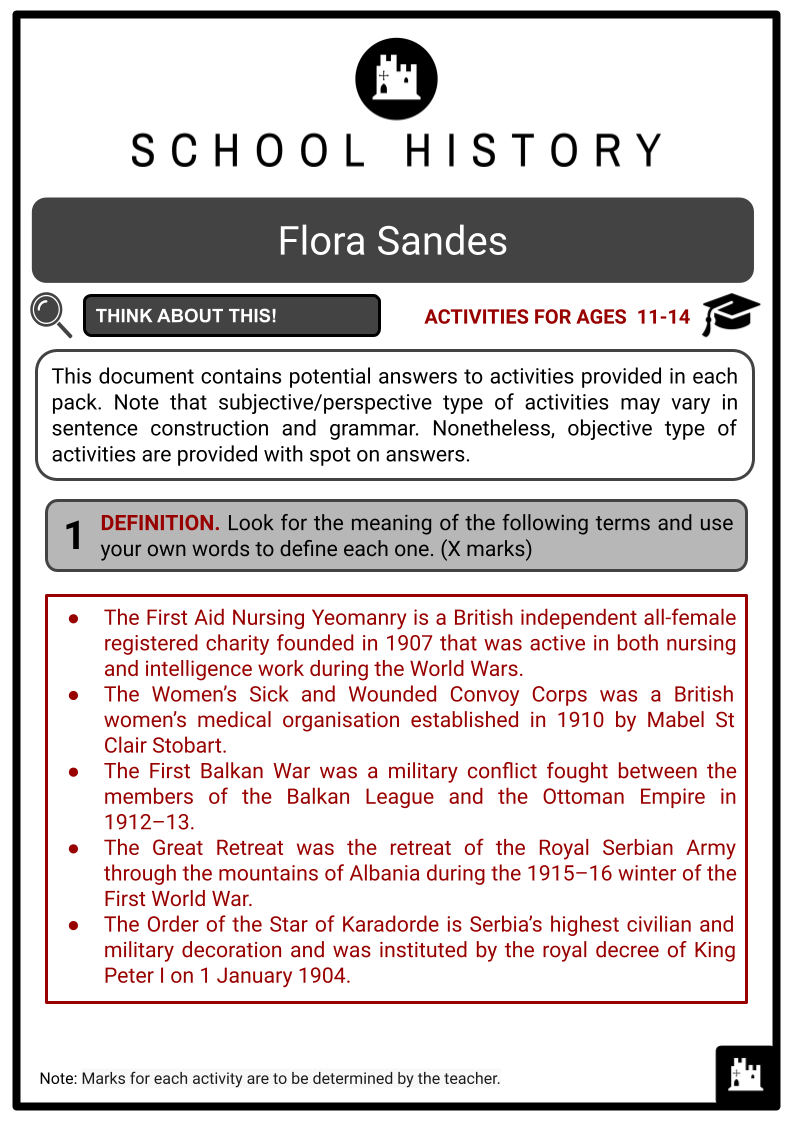Flora Sandes Worksheets
Do you want to save dozens of hours in time? Get your evenings and weekends back? Be able to teach about Flora Sandes to your students?
Our worksheet bundle includes a fact file and printable worksheets and student activities. Perfect for both the classroom and homeschooling!
Resource Examples
Click any of the example images below to view a larger version.
Fact File


Student Activities




Summary
- Early years and career
- Military service
- Later years
Key Facts And Information
Let’s know more about Flora Sandes!
Flora Sandes was the only British woman officially enlisted as a soldier in the First World War. She received her first aid and military training by joining the First Aid Nursing Yeomanry and later the Women’s Sick and Wounded Convoy Corps, with whom she volunteered during the First Balkan War. From 1914, she was part of the Red Cross ambulance units in Serbia. In order to ensure her safety following the Great Retreat, she enrolled as a member of the Serbian Army. She fought in the war and was promoted a few times. The publication of her autobiography in 1916 helped raise funds for the Serbian forces.

Early years
- Born on 22 January 1876 in Nether Poppleton, County of York, Flora Sandes was the youngest daughter of eight children of a Protestant Anglo-Irish family from Cork. Her parents were Sophia Julia Besnard and Samuel Dickson Sandes, a rector in their community who previously worked in Cork and Durham. Her family was not wealthy, but was able to live comfortably.
- Sandes’ father had a hard time finding permanent employment, having failed to establish himself in several parishes. This was the reason her large family moved at least five times during her childhood.
- The family made the best of it in each town and village they relocated to, with each member of the family actively participating in the activities and improvement of the parish church.
- Sandes was nine when her family finally settled in Suffolk. Her father was employed as the rector of a small church in Marlesford.
- Although the rural village was small, it was wealthy enough to be connected to other towns in the district through its own small railway station.
- Sandes had a happy upbringing in the village, spent among a close-knit group of family members and parishioners.
- She received her early education at home under the guidance of governesses. She was later sent to Switzerland, where it was hoped that she would acquire the necessary skills to become a well-rounded and leisured young lady.
- By the time she finished school, she could speak both French and German, which proved advantageous later on.
- She read avidly, and this fuelled her desire to see the world for herself. She also enjoyed riding and shooting in the countryside surrounding Marlesford, unlike most girls of her age.
- She envied the freedom enjoyed by her brothers, and, in fact, in her early childhood, wished that she was a boy.
- Some of Sandes’ siblings left Marlesford to pursue careers or settle down with their own families elsewhere.
- In 1894, the remaining members of the family moved to Thornton Heath, near Croydon. The primary purpose of the move was to make sure that the 18-year-old Sandes and her sister Fanny were within easy reach of London. Both aspired to become writers at the time.
- Sandes completed a course in secretarial training and soon started work in the capital.
- In search of adventure, she then took a job as a typist in Cairo. She worked there for a year and then moved to New York with her friend. Still working as a typist, she moved from city to city across Canada and America.
- When Sandes returned home to England, she continued exploring unfeminine hobbies that were unexpected of a middle-class woman such as herself. She learnt to drive, owned a French racing car and joined a shooting club. By the time she turned 30, she was fiercely independent, still living at home and single.

Military service
- In 1907, the First Aid Nursing Yeomanry (FANY) was formed and sought to put together a group of women to gallop on the battlefields of a future war to rescue the injured. Sandes, who craved thrills, was interested and became one of the pioneering group. This is where she improved her horsemanship and learnt first aid, signalling and drill.
- By 1909, Sandes was a ‘corporal’ and one of the most active members of the London-based organisation.
- In the same year, many FANY members, including Sandes, were unhappy with the organisation’s poor leadership. They split from FANY and became part of the Executive Committee of the Women’s Sick and Wounded Convoy Corps (WSWCC).
- The influence of Sandes and other members left the WSWCC with a distinctly pragmatic approach, with a focus on practicality rather than elegance. Skills like trench-digging, tent-pitching and formation-marching were taught in addition to training in horsemanship and first aid. Unlike the FANY, the WSWCC activities satisfied Sandes.
- During the First Balkan War of 1912, the WSWCC volunteered their support to Serbia and Bulgaria, and Sandes went with them.
- At the outbreak of the First World War in 1914, Sandes attempted to volunteer as a nurse. However, the War Office rejected her due to a lack of formal qualification.
- This did not stop Sandes’ desire to take part in the war, as she joined a St John Ambulance unit raised by American nurse Mabel Grouitch.
- In August 1914, the unit, largely comprised of American volunteers, left for Serbia to aid in the humanitarian crises there.
- On arrival of the group in the town of Kragujevac, the base for the Serbian forces fighting against the Austro-Hungarian offensive, Sandes immediately joined the Serbian Red Cross.

- She was posted to the ambulance assisting the Serbian Army’s Second Infantry Regiment, who were well-known for their battle prowess, hence were likely to be involved in much fighting.
- This period saw the tides of war turn against the Serbian forces, who therefore had to retreat, along with the nurses.
- Despite the efforts of people who advised her to return to safety, Sandes stayed and decided to join the ambulance unit of the Second Regiment at the Babuna Pass in 1915.
- During the Great Retreat through Albania, the ambulance staff either fled or were killed.
- As hospital work was no longer viable, Sandes found retreat life hard and dangerous.
- To ensure her safety, she was enrolled as a member of the Serbian Army by General Miloš Vasić and became a soldier in her own right.
- She swiftly advanced to the rank of corporal because of her exceptional skills.
- In 1916, she was severely injured by a grenade during the Serbian advance to reclaim Monastir.
- Following this injury, she received the highest available decoration of the Serbian Military, the Order of the Star of Karadorde, and was promoted to the rank of Sergeant Major.
- Her injury left her unable to return to the fighting force, and so she focused on publishing her autobiography titled ‘An English Woman-Sergeant in the Serbian Army’ in the same year.
- She used this account to help raise funds for the Serbian Army, particularly to improve the levels of comfort provided to those that had been taken prisoners.
- She also spent the remainder of the war running a hospital to help the sick and the wounded.
- In June 1919, a special Act of Parliament was passed in Serbia that declared Sandes the Serbian Army’s first female commissioned officer. In October 1922, she was finally demobilised and retired at the rank of Captain.
Later years
- By 1927, Sandes had returned to civilian life and continued to live in Serbia. That year, she married Yuri Yudenich, a former Russian White Army general officer. She also published a second autobiography. They lived for a time in France and settled in Belgrade.
- Wearing her military uniform, Sandes gave numerous lectures about her wartime experiences in the United Kingdom, Australia, New Zealand, France, Canada and the United States.
- In the course of the Second World War, Germany launched its attack on Yugoslavia in 1941. Sandes and her husband were once more called to action.
- The invasion was complete before they arrived in military lines. The two were briefly held by the Germans before being released on parole.
- In German-occupied Belgrade, Sandes’ husband died of a heart condition. She subsequently spent almost three years living in poverty.
- When the city was liberated, she returned to the UK and moved back to the Surrey region.
- Sandes spent the last years of her life near her family in Rhodesia and Surrey. On 24 November 1956, she died at the age of 80, following a final visit to Serbia for a reunion of her old colleagues from 1915.
Image Sources
- https://upload.wikimedia.org/wikipedia/commons/thumb/2/22/Flora_Sandes_in_uniform.jpg/250px-Flora_Sandes_in_uniform.jpg
- https://upload.wikimedia.org/wikipedia/en/7/7b/First_Aid_Nursing_Yeomanry_centenary.png
- https://upload.wikimedia.org/wikipedia/commons/2/28/Women%27s_Sick_and_Wounded_Convoy_Corps_Q69131.jpg
Frequently Asked Questions
- Who was Flora Sandes?
Flora Sandes was a British woman who served in the Serbian army during World War I. She became the only British woman to officially serve in the war.
- Why did Flora Sandes join the Serbian army?
Sandes was drawn to Serbia and its cause during World War I. Initially, she volunteered as a nurse but later enlisted as a soldier, motivated by a desire to contribute to the war effort and her admiration for the Serbian people.
- Was Flora Sandes the only female soldier in World War I?
While Sandes was not the only woman to serve in various capacities during World War I, she is notable for being the only British woman officially recognised as a soldier and serving in combat.
